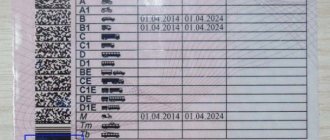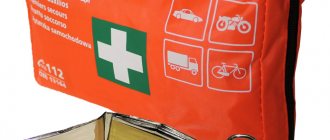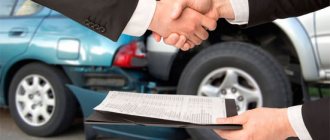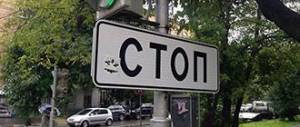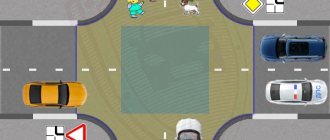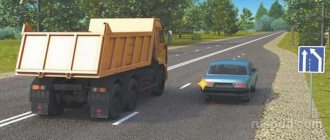When a person finds himself behind the wheel of a car without extensive driving experience, the question immediately arises regarding proper braking near traffic lights.
After all, if you don’t stop on time at a red light, there is a very high probability of hitting a pedestrian or causing an accident with other vehicles. You should approach intersections confidently and carefully so as not to break the rules or create dangerous situations.
Braking on a manual transmission is objectively more difficult when compared with automatic transmissions. But every driver, regardless of the type of gearbox, must know how to brake correctly at a traffic light.
The tasks of careful braking
Let's first determine why a driver needs to know how to brake carefully and competently. After all, you can hit the gas pedal sharply. The vehicle still needs to be stopped.
But it is important not only to stop driving in front of a traffic light if the driver has a red light, but also to do it extremely carefully. There are several reasons to do this.
- Passengers. It's a matter of their convenience. When a driver is behind the wheel of his vehicle for a long time, he often does not even pay any attention to the various jerks of the car. But passengers will feel it very well. Each push leads to far from the most pleasant sensations. And if there are small children among the passengers, sudden braking is completely dangerous for their health. Same for older people.
- The need to quickly correct errors. It is not difficult to imagine how a car moves along a snowy road. And if you brake by sharply pressing the pedal, there is a high probability that the car will not stop. And if you also hit a puddle or an icy area, then you are probably guaranteed to turn red. Or driving into the rear bumper of the car in front. The driver simply won’t have time to correct his mistake. Therefore, the number of accidents increases sharply in winter.
- The situation is under complete control. If you brake correctly, you will avoid crashing into the cars in front, and you will also prevent the car behind you from ramming your rear bumper. So proper braking is one of the components of accident-free operation of a vehicle.
There is hardly any point in arguing that it is necessary to learn to brake.
At the same time, do not forget about the difference between automatic and manual transmissions. The automatic transmission greatly simplifies the life of the motorist. But not everyone can or not everyone wants to buy a car with an automatic transmission. Therefore, you have to use a more complex scheme to stop at a traffic light.
Anti-lock braking system
Another discovery of the modern automotive industry is the anti-lock braking system ABS. When you press the brake pedal sharply, the car's wheels will not skid, but will remain under the control of the car computer.
Under normal road conditions, a vehicle equipped with ABS has a significantly reduced braking distance. Extreme situations, when the wheels of the car skid or slip, are minimized. A car equipped with an ABS system does not skid.
If your car has such a system, questions about proper braking with ABS are unnecessary, just start braking. At some points on a slippery road surface or in other difficult road conditions, the brake pedal begins to tremble and put pressure back on the driver's foot. There is no need to worry, the ABS system is working, continue to brake confidently.
A number of car models are now equipped with a button to turn off the ABS system. Sometimes seasoned car owners use this function. But even for them, we do not recommend turning off the system! If your car does not have such a button, but you still need to disable the ABS, then this can be easily done by removing the fuse responsible for its operation.
There is an opinion that the use of the ABS system leads to an increase in braking distance. This opinion will be correct only under the following conditions:
- The road surface is uneven and loose . For example, gravel or sandy surface, deep snow. Under such conditions, a car not equipped with ABS will most likely “burrow” and stop moving if the wheels are blocked. It is in such conditions that experienced motorists use the function of disabling the anti-lock braking system.
- “Bald” tires . Driving on such tires becomes much more dangerous in a car equipped with ABS.
ABS has a number of irrefutable advantages that make braking easier in difficult conditions:
- There is no need to make a series of quick and intermittent presses on the brake pedal - the ABS is activated with 1 long press
- The car remains under full control of the driver.
- Even sharp maneuvering at higher speeds is now possible, since the ABS braking system is more sensitive and confident.
Automatic transmission braking
First, let's tell you a little about how to stop correctly at a traffic light if your car is automatic.
If a manual transmission is divided into speeds, then an automatic transmission has different modes. The emergence of a new type of gearbox design has led to the fact that it has become much easier to brake and start on cars with automatic transmission. Especially when it comes to novice drivers.
Automatic cars are literally designed for driving in urban environments. They allow you to quickly stop at a traffic light without extra effort and many manipulations, and then just as easily set the starting speed of the vehicle.
To stop at the entrance to an intersection, the driver needs to smoothly release and press the brake pedal. As a result, the car will stop. But the main thing here is not to let go of the pedal if you are in Drive mode. It automatically sets the car to move at a speed of about 20 kilometers per hour.
As soon as the automatic transmission vehicle can be stopped, keep your foot on the brake pedal until the red light turns on. Then release the pedal and press the gas.
In addition to braking with the brake pedal, automatic transmissions also have the ability to stop the car with the engine. This is where recommendations from more experienced drivers come to the rescue. But in fact, you won’t have to carry out any complex manipulations.
When a descent is visible ahead, the automatic transmission switches to S mode from the current Drive position (or simply D). If the slope is steep enough, then you can switch from Drive to L mode. Here you should start from your own feelings.
Additionally, on automatic transmissions there is a Hold button, which will help you with engine braking.
It is better to use this method of stopping in emergency situations when the brake pedal has failed. Although some actively practice this method if they need to slow down or stop when driving down a steep or long descent. But if there are no problems with the brake pedal and the entire braking system, it is better to use the traditional method. After all, brakes are designed to pause or completely stop the movement of a vehicle.
What to do if the brakes fail
- Warn other drivers! Signal and turn on your hazard lights
- At low speeds, it makes sense to use the handbrake. We press the button and smoothly lift the lever, while paying attention to the clicks, and do not allow sudden braking and blocking of the car wheels.
- Is handbrake braking impossible for some reason? Brake the engine! In critical conditions, it is necessary to turn off the ignition and turn on first gear. In this case, a breakdown of the gearbox or engine is guaranteed, but life is much more important.
- Can't stop? Then look for items that can serve as a deterrent. Damage from a collision with them should be minimal. Thickets of bushes, snowdrifts, and piles of garbage are suitable.
Regardless of what gearbox your car is equipped with or what road surface you are driving on, you first of all need to be firmly confident in your capabilities. That is why, before you get behind the wheel of a high-risk vehicle and drive onto a busy highway, you have to learn how to brake correctly.
Braking with manual transmission
Now let’s take a closer look at the question of how to stop correctly at a traffic light using a manual transmission. If you remember your lessons at a driving school, you will probably remember the words of the instructors who told the students that the vehicle should always move with the gear engaged at the checkpoint.
Which gear to choose depends on the speed of travel, in order to always be ready to make the next maneuver, based on the current situation on the road. And only when it is necessary to completely stop the car at a speed of about 5-10 kilometers per hour, you should depress the brake and clutch pedals at the same time.
But what’s interesting is that in practice, most drivers with little to no impressive experience rarely use the engine braking method. This can be explained by the need to frequently downshift gears, which provokes fairly rapid fatigue. Plus, such movements lead to increased fuel consumption in urban environments. Do not forget that this method of braking causes accelerated wear of the elements of a manual gearbox.
If the weather is dry and the road is paved with asphalt, it is much easier and more convenient to brake before a traffic light without downshifting. It is much more practical to smoothly and simultaneously depress two pedals in the car, rather than try to stop the vehicle with the engine itself.
There is nothing complicated about braking with two pedals. All you have to do is learn how to squeeze them with the right speed and force. This already depends on how easily the pedals move specifically on your car. Plus, the speed of pressing is directly affected by the very speed of the vehicle in front of the traffic light. The faster you went, the harder you had to squeeze the pedals. But it’s better not to accelerate too much if you know that there is an intersection ahead.
At the same time, you should under no circumstances refuse to learn engine braking techniques. We recommend that you learn how to stop correctly at a traffic light. Otherwise, you risk stalling.
Many people are rightly interested in how to brake at a traffic light so as not to stall at the manual transmission. After all, then you will have to turn the key in the ignition switch again, repeat the start procedure again, etc.
- The essence of the engine stopping technique is to force the car to stop while the gear is engaged on a manual transmission.
- If you have the same 2nd or 3rd gear engaged, when you press the accelerator pedal, the car will begin to accelerate. That's how cars work.
- If you stop pressing on the gas, but leave the speed on, the engine itself will gradually begin to stop the car.
- The time spent braking directly depends on the gear currently engaged. The lower it is, the faster the vehicle will stop.
- When you approach a traffic light, it's a good idea to downshift early.
It is important to understand that this stopping technique increases fuel consumption. But the effectiveness of such braking is higher, which has a positive effect on the safety and confidence of the novice driver.
In the described method, the brake pedal is practically not needed. But if you feel such a need, you can use it to slow down a little. Even if you press the brake pedal to the floor while in gear, the vehicle will still not stop. But you can cause serious damage to the brake mechanisms.
When braking, you don't have to use the brake pedal. Squeeze it when the car has already moved to minimum speed due to the engine stopping. This will allow you to fix on the line that separates the area for cars from the pedestrian crossing. This way you will not go beyond the established limits and will not roll out into the lane along which other cars are moving perpendicularly, since the green light has turned on for them.
We should never forget about the need to secure the car when stopping at controlled intersections, where there are traffic lights or traffic inspectors. This is especially true for areas that have uneven surfaces and where there is quite a lot of traffic.
When another vehicle is closely behind your car, even a small rollback will cause an accident. If you fix the car in a stationary state, pressing the brake pedal, then there will be no talk of any collisions.
When you have to stop on a descent or ascent, it definitely helps to use the parking or hand brake. It is recommended to use it during lessons at a driving school. When you turn on the handbrake, the car is guaranteed not to move. Therefore, it will not pose a threat to vehicles behind or in front of you. When the time comes to move, first start moving, and then gradually release the handbrake. Throwing on the parking brake and then trying to depress the clutch and shift into first gear is extremely dangerous when there are other cars behind you. You simply won’t have time to complete all the necessary manipulations, but will start to roll backwards.
Practice shows that for beginners, a more correct and convenient solution would be to use the engine braking method from high gears to lower gears. This removes pressure from the gas pedal. Just before stopping, you can use the brake pedal or handbrake to fix the position of the vehicle.
Confident and more experienced drivers prefer braking by simultaneously pressing two pedals. This allows you to quickly brake at different speeds, regardless of the gear engaged. Plus, this stopping technique allows you to use fuel more economically.
The right start
Also, everyone wants to know how to properly start at a traffic light with a manual transmission. With an automatic transmission everything is very clear, but there are several questions regarding the manual transmission.
If you are interested in how you can learn to quickly move away with a manual transmission while standing at a traffic light, then first try to remember the lessons from your driving school. To quickly start moving, instructors usually advise starting with the clutch, without using the gas pedal. But such a technique is quite dubious, since it will be problematic to do this in dense traffic conditions. You will become an object for expression of aggression and more.
We must not forget that different cars have their own characteristics of setting up and adjusting the clutch. This starting method is suitable if the road is empty, level and horizontal. But it is better to refuse it when it comes to descents, ascents and busy intersections. Here, experienced drivers advise driving a little differently.
Before driving through a manual traffic light, you will have to set the vehicle's initial speed from a complete stop. That is, you need to get moving. To do this, let's simulate the situation. The car stopped at a traffic light or intersection. At the same time, the driver has turned on the handbrake, the engine is running, and the manual transmission knob is in the neutral position.
- With your left foot, you need to press the pedal, which is responsible for the clutch, all the way.
- In parallel, with the right hand, the driver engages first gear on the manual transmission.
- Next, the car can be gradually released from the handbrake.
- If necessary, turn on your turn signal to indicate to other drivers that you intend to turn at the traffic light.
- Now the clutch pedal is released smoothly.
- When the moment of seizure comes, stop releasing the pedal for a couple of seconds and simultaneously apply gas with the accelerator pedal.
- At the same time, the speed on the tachometer will begin to increase.
- It is recommended to start at 1000-1500 rpm. It is not recommended to raise the rpm above 2500, since you are not a racer and do not intend to compete with anyone in starting speed.
- At the same time, monitor the movement of the tachometer needle, since it is not always possible to determine the load on the engine only by its sound.
- Try to clearly control the force with which you apply your foot to the gas pedal. To feel it better, try to drive in soft shoes.
- If you do everything correctly and lightly press the gas pedal, the car will move.
- Without lowering the clutch pedal all the way, drive about 3 meters. This mode is called semi-clutch driving.
- Now you can completely leave the clutch and press the gas pedal even harder. This will allow you to change to the next gear by pressing the clutch again.
Under ideal conditions, you should release the clutch pedal and press the gas carefully, smoothly and synchronously. But this can only be achieved as your driving experience increases. If a beginner stalls or presses on the gas pedal in the first couple of minutes, it’s okay. Soon you will get used to the operation of the manual transmission and the pedals of your car, thereby learning to move away smoothly.
